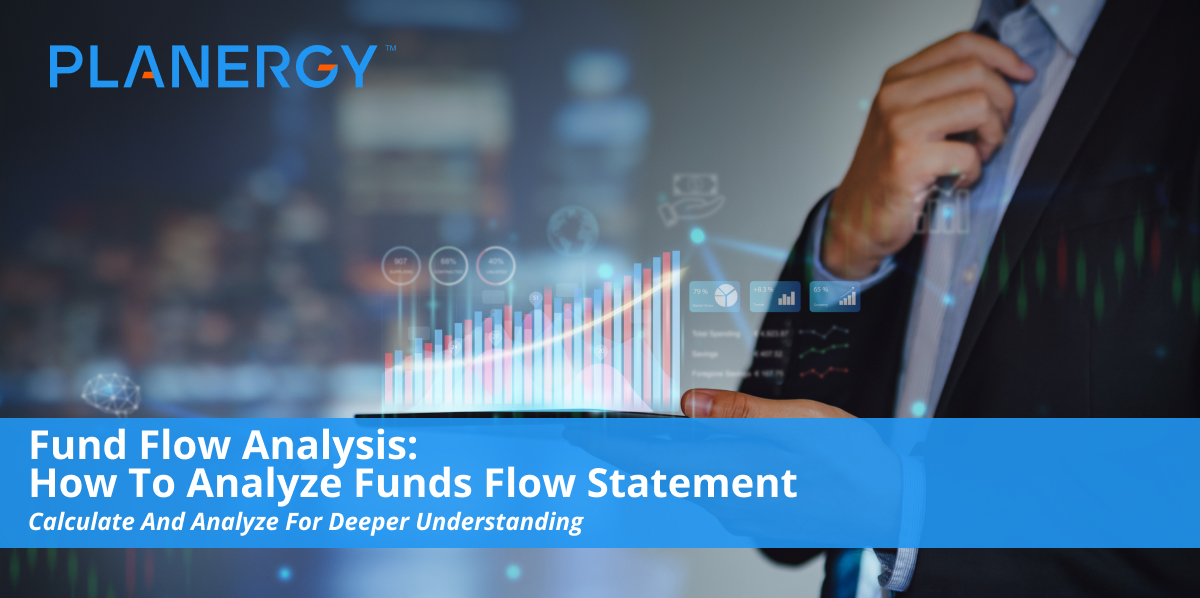Fund Flow Analysis
Fund flow analysis is used to understand changes in financial position. Similar to a cash flow statement, fund flow statement analysis uses financial statements such as a balance sheet or income statement in its analysis.
Most businesses use a combination of three main financial statements to analyze business finance and operations.
- Balance sheet: A balance sheet provides a summary view of all asset, liability, and capital accounts and their current balances as of a specific period of time.
- Profit and Loss/Income Statement: The profit and loss or income statement is used to summarize revenue, expenses, and profit or loss earned for a specific period of time.
- Cash flow statement: Most similar to a fund flow statement, the cash flow statement measures cash inflow and outflow during a particular period of time by looking at the inflow of cash and cash outflow from operating activities, investing activities, and financing activities.
While a single balance sheet can provide details on current assets, liabilities, and equity, it’s impossible to determine where those funds came from or how they have been used.
One of the most useful things about fund flow analysis and a fund flow statement is how it looks at two different accounting periods, providing detailed information on the changes taking place between the current year and the previous year.
Though similar to the cash flow statement, fund flow statements differ in the following ways:
| Cash Flow Statement | Fund Flow Statement |
| Looks at cash in hand, bank balances, and cash equivalents, and accounts payable balances | Is always based on accrual accounting |
| Looks at increases or decreases of current assets and current liabilities to determine level of cash use | Looks at activity of long-term funds, including any increases or decreases |
| More useful for assessing the current financial position or liquidity position of the company | More useful for long-term planning |
| It displays cash flow from operating, financing, and investment activity | It displays funds generated from long-term assets, long-term liabilities, and equity |
| Good cash position always indicates good fund position | Good fund position does not automatically mean good cash position |
While both are valuable to an organization, the cash flow statement is designed to address current and short-term cash flow and cash position, while the fund flow statement is much more useful for organizations looking to plan for the future.
Why do you need a fund flow statement?
With cash flow statements, profit and loss statements, and balance sheets at your fingertips, what information does the fund flow statement provide that is not available on any of those reports?
Let’s take a quick look at a balance sheet. Let’s say your current assets increased from $200,000 in 2020 to $275,000 in 2021. While the balance sheet can show you the increase or decrease in current assets, it can’t show you exactly why those assets increased. Do you have more inventory on hand? Did your bank balance increase significantly? Did your accounts receivable balance increase? Looking at your balance sheet, you don’t know the answer to that. And while your cash flow statement can help to pinpoint changes from period to period, a cash flow statement only includes transactions that directly impact cash or cash equivalents.
By focusing on changes in working capital, a fund flow statement can pinpoint exactly what changed during the period in question. But the fund flow statement takes it a step further by indicating exactly how those additional funds have been used.
Businesses can operate more efficiently if management is aware of their true financial position That means not just looking at net income but digging deeper to see what changes have happened during a specific period of time, and what was the underlying cause of those changes.
The importance of a fund flow statement
Not everyone’s business will need to create a fund flow statement. Small businesses with limited assets that are not publicly held can forego the creation of a fund flow statement and use the other financial statements at their disposal.
Formatting a fund flow statement
There are three parts to a fund flow statement; the Statement of Changes in Working Capital, Funds from Operations, and the Fund Flow Statement. To begin preparing a fund flow statement you first have to create the Statement of Changes in Working Capital. This is done by measuring the difference between current assets and current liabilities displayed on the balance sheets for the period which you wish to create a fund flow statement for.
| Current Assets | 2021 | 2020 | Change in Working Capital |
| Cash and cash equivalents | 310,000 | 220,000 | +90,000 |
| Accounts receivable | 90,000 | 125,000 | -35,000 |
| Inventory | 190,000 | 175,000 | +15,000 |
| Other current assets (including short term loans) | 82,000 | 80,000 | + 2,000 |
| Total Current Assets | 672,000 | 600,000 | +72,000 |
| Current Liabilities | |||
| Accounts payable | 102,000 | 101,000 | + 1,000 |
| Other expenses | 71,000 | 75,000 | – 4,000 |
| Total current liabilities | 173,000 | 176,000 | – 3,000 |
| Net working capital | 499,000 | 424,000 | +75,000 |
| Total change in working capital | 75,000 |
The Statement of Changes in Working Capital is the most important part of the fund flow statement since it determines whether to record changes as sources of funds, which occurs with an increase in working capital, or an application of funds, which occurs when there is a decrease in working capital.
The next step is to prepare the Statement of Funds from Operations. This is done by obtaining your total profit and loss for the period in question from your financial statement, adjusting the totals by adding back non-cash expenses such as depreciation, write-offs, taxes, and accrued interest to obtain your actual fund from operations.
For example, if your net income on your profit and loss statement is $155,000, and your non-cash expenses total $27,000, you would add the two together, which totals $182,000. In addition, you also issued shares of stock to the public which totaled $20,000.
Creating a fund flow statement
Now that you have calculated your change in working capital and have also obtained your total amount of funds from operations and your total stock issue, you’ll need to begin the preparation of a fund flow statement. Remember that the fund flow statement is divided into two sections; sources of funds and application of funds.
Sources of Funds
The sources of funds area is where you would show the total changes for the chosen period of time as well as the fund source. Items that should be listed under sources of funds include:
- Funds from operations
- Sale of fixed assets
- Sale of investments
- Issue of shares
- Long-term loans
Application of Funds
The application of funds area provides a detailed list of how funds were used. Included in this section should be the following:
- Loss from operations
- Dividend payments
- Tax payments
- Fixed asset purchase
- Loan repayment
These are not the only items that may appear on a fund flow statement but are some of the more common ones.
| Fund Flow Statement | 2021 |
| Source of Fund | |
| Funds generated from operating activities | 182,000 |
| Processed from stock issue | 20,000 |
| Total Source of Funds | 202,000 |
| Application of Fund | |
| Purchase of fixed assets | 127,000 |
| Increase in working capital | 75,000 |
| Total Application of Funds | 202,000 |
What are the key benefits of creating a fund flow statement?
There are numerous benefits to creating a fund flow statement. Here are just a few of them.
Displays current financial position
Businesses can operate more efficiently if management is aware of their true financial position That means not just looking at net income but digging deeper to see what changes have happened during a specific period of time, and what was the underlying cause of those changes.
Details share capital information
If you regularly issue stock, knowing your share capital information is just as important as knowing your income from operations. Creating a fund flow statement displays that information, allowing you to consider that amount when calculating your fund sources.
Explains the reasons behind the changes in funds
It’s easy enough to look at the current accounting period’s balance sheet or profit and loss statement to determine whether you’ve increased or decreased working capital. But isn’t it just as important to know the reasons why those changes have occurred? A fund flow statement provides the details you need to see exactly where funding is coming from and how it’s being used.
Essential for long-term planning
When creating long-term financial analysis for your business, having access to details such as stock issuance, and working capital can help you prepare a more accurate financial forecast.
An essential tool for investors
Potential investors look at many things before deciding whether to invest in a company, and the fund flow statement is one of them. Fund flow statements provide essential information such as company liquidity, how funds are obtained, and the uses of funds. Fund flow statements are also useful for banks and other lenders who wish to see a more in-depth picture of your business to determine creditworthiness.
Limitations of the fund flow statement
There are limitations to the fund flow statement, including its lack of originality. In its true form, the fund flow statement uses information from other financial statements that business owners already have access to, making the report redundant in some cases. Another issue is that it does not address the movement of cash such as fund inflows or outflow of funds from your business, concentrating only on fund origination and use. In a best-case scenario, a business would continue to utilize other financial statements such as a balance sheet, income statement, and cash flow statement to get a more nuanced view of the company’s financial health.
Solid financial management requires more than a quick review of your balance sheet and income statement. By adding the fund flow statement and fund flow analysis to your financial planning process, you have quick access to your working capital positions along with a more in-depth look at business operations.




